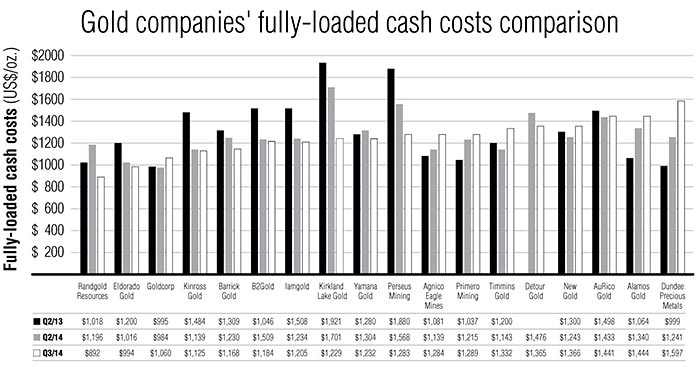VANCOUVER — Cost optimization has been an underlying theme for gold miners over the past few years. Falling metal prices and frugal capital markets have made it hard to balance sustainable production growth and strong profit margins. In most cases profits have won out, as producers have committed to cutting cash costs at the expense of undercapitalizing mines.
According to an early December report released by Dundee Capital Markets (TSX: DCM), however, it is “readily apparent that costs have remained sticky” in the gold space. Dundee modelled the fully loaded cash costs (FLCC) for 18 gold producers in its coverage sphere, and found that only nine had positive margins before accounting for growth capital, dividends or debt repayment.
Dundee defines FLCC as the sum of: total cash costs (including royalties), general and administrative expenses (G&A), exploration expenses, cash taxes, cash interest and true sustaining capital costs. Under the FLCC metric and a US$1,287 per oz. gold price, the investment firm determined that cash margins were on average negative US$5 per oz. during the third quarter, which is down from US$33 per oz. during the comparable period in 2013.
According to the report, total cash costs rose on a year-on-year and quarter-on-quarter basis despite the industry’s “best efforts.” Dundee attributes the rise to a number of things, including: operational challenges, higher-cost mines, introduction of new taxes and royalty regimes, and operating cost inflation.
Sustaining capital was a large source of savings, with quarterly budgets down 15% year-on-year. Meanwhile, G&A costs decreased 10%, with savings driven by labour reductions at both the corporate and mine level. Dundee cites recent corporate cost-cutting by Barrick Gold (TSX: ABX; NYSE: ABX), Iamgold (TSX: IMG; NYSE: IAG), and Kirkland Lake Gold (TSX: KGI; US-OTC: KGILF).
“While we concur that balance sheets should be managed prudently, we remain cautious, as sustaining capital expenditures (capex) are essential to maintain asset productivity,” Dundee analysts note.
“While undercapitalizing mines provide a near-term capex reprieve with no immediate impact on operations, we remain conscious of the longer-term risks, which include sterilization of resources, inadequate exploration to replace reserves, and/or insufficient maintenance and development expenditures, which could result in future operational disruptions,” the report concludes.
The other major casualty has been greenfield exploration budgets. Dundee notes cuts to “ancillary spending on non-core projects, with exploration budgets being cut back or eliminated altogether.”
Weighted-average exploration costs amongst the firm’s coverage companies dropped 29% year-on-year, which is an industry-wide trend, according to SNL Metals & Mining, as grassroots exploration budgets have declined “58% over the past two years in a response to declining gold prices.”
Dundee’s report includes companies that range from larger-scale producers to smaller outfits with a single operation.
The report notes that companies operating with below-average FLCC tend to be established miners with higher-quality assets, while smaller operators can “experience volatile FLCC due to lumpy capex spending, and the transitional producers continue to invest in order to work their way up to design production capacity.”
On the larger-cap side Barrick’s third-quarter FLCC improved by US$141 year-on-year to US$1,168 per oz. The reduction is mostly thanks to a US$69 per oz. drop in sustaining capex, as well as the company’s significant capital savings from asset sales and closures.
Meanwhile, Goldcorp (TSX: G; NYSE: GG) has kept costs steady over the past year. The company’s third-quarter FLCC increased marginally to US$1,060 per oz. Dundee estimates that Goldcorp “will remain a lowest quartile-cost product through 2016, driven by a lower-operating cost structure and increasing production from its development pipeline.”
Agnico Eagle Mines’ (TSX: AEM; NYSE: AEM) quarterly FLCCs jumped US$203 during the period to US$1,284 per oz. Higher operating costs were realized at a number of the company’s mines — including LaRonde and Kittila — plus adding a full quarter of production at the recently acquired Canadian Malartic asset. Agnico’s FLCC is predicted to fall back down to US$1,078 per oz. by 2016.
One of the largest portfolio-optimization efforts has come from Kinross Gold (TSX: K; NYSE: KGC), which suffered massive writedowns over the past few years due to its US$7.1-billion acquisition of the Tasiast project from Red Back Mining in 2010. The company decreased its FLCC in the third quarter by US$359 year-on-year to US$1,125 per oz.
Kirkland Lake also pursued major cost-cutting initiatives and committed to producing higher-quality ounces from its Macassa mine complex. Kirkland Lake saw its FLCC plunge from US$1,921 per oz. in third-quarter 2013 to US$1,229 per oz. in third-quarter 2014. Dundee adds that “much of the excess” has already been eliminated from the company’s cost structure, and expects further reductions to be more “modest and gradual.”
In terms of mid-tier producers with rising year-on-year FLCC metrics, Alamos Gold (TSX: AGI; NYSE: AGI) was up US$380 during the third quarter at US$1,444 per oz. due to rising sustaining capex attributed to underground development at the company’s Mulatos mine.
In addition, Primero Mining (TSX: P; NYSE: PPP) saw its quarterly FLCC rise US$250 year-on-year to US$1,289 per oz. Cost increases were fuelled by commissioning challenges related to the company’s San Dimas mill expansion, and high capital investment at its recently acquired Black Fox mine.
“While efforts remain underway to trim spending across the spectrum, we note that costs, for the most part, remain sticky, making it difficult to implement sweeping reductions without drastically overhauling operations,” Dundee concluded. “While some would argue these changes are necessary, the gold miners find themselves in a challenging predicament where short-term profitability must be weighed against long-term sustainability.”


Be the first to comment on "Dundee: Gold miners continue to wrestle with costs"